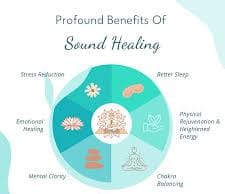
Among the various modalities practiced in the sphere of alternative medicine, sound healing is probably the most effective one. Its attributes and mainly the ability to help a person relax and regain his or her balance have led to its widespread use in numerous natural treatments.
In this post, we discuss the most important questions about the effectiveness of sound healing: tips from professionals and its use in complementing medicine and other healing methods. These will compactly address the questions of those who have just started learning about and actually engaging in sound healing as well as those who wish to move forward in their practice.
How can sound healing improve holistic health care?
Sound healing improves holistic health care by balancing the body’s energy fields and reducing stress. This non-invasive therapy aligns with natural healing therapies to promote physical, emotional, and spiritual well-being.
With the incorporation of sound healing, there is a successful restoration of your mind body balance and improved health. The healing effects of it also comfort the patient and assist him or her in their individual healing.
In-depth sound therapy is likely to bring about monumental changes in the different areas of functioning, especially when included in the holistic healing systems. Decreased anxiety levels, better sleep, and greater relaxation are among the positive changes many people have reported after using sound therapy frequently. This is effective in most of the health and healing practices and hence should be embraced in every wellness and healing journey.
What are expert tips for maximizing the benefits of sound healing?

To maximize benefits, experts recommend consistency in sessions, combining sound healing with complementary medicine, and practicing mindfulness.
Together with other measures, it equips patients for sound therapy, promoting a better treatment response when vibrations are introduced to the body. This can be done by adopting a relaxation technique and concentrating on your breathing before and during the sessions to achieve maximum benefits when performing sound therapies.
Since they are specifically designed for particular patients, results can also be improved by employing appropriate frequencies. In patient-centered healthcare, using sound healing techniques, some practitioners recommend using guided imagery or meditation as supportive therapies for sound.
Can sound healing be used with other natural healing therapies?
Yes, sound healing works well with other natural healing therapies like herbal medicine for holistic care, yoga, and meditation.
The practice of combining these modalities has been reported to improve relaxation, reduce pain, and generally be restorative. Several practitioners believe that sound therapy should not be practiced in isolation and that its application improves other alternative healing practices, thereby completing the healing process.
As an illustration, the use of sound healing techniques within the framework of yoga practice may enhance the depth of meditation and increase people’s sensitivity to their own bodies more powerfully. On the same note, when herbal treatments are used in conjunction with sound therapy, the effectiveness of both is maximized, resulting in improved outcomes. This combination of treatments is gaining popularity in alternative medicine as well, where patients experience more and heal better through the synergy of therapies.
How often should you practice sound healing for the best results?

For best results, practitioners suggest weekly or bi-weekly sound healing sessions.
Making sound baths a part of regimens to include self-healing initiates even more probable long-range sound therapy positives that include an improved state of mind. Sound therapy is not a once off treatment but a continuing long-range form of intervention, and for best results one should practice it regularly.
Apart from the routine Healing sessions of sound therapy, self-healing through the use of sounds can be a booster of the therapy benefits. This kind of traditional therapy should be complemented with listening in, on sound baths or therapeutic music, practicing sound therapy, and most ideally, whilst busy with work or relaxing in order to try and keep that calm every day of the week. People who engage actively in sound mending will quite easily attune their mind and body systems as the body will respond greatly.
What equipment is most effective for sound healing?
The most effective equipment for sound healing, as per expert practitioners’ recommendations, are tuning forks, Tibetan singing bowls, and gongs.
These apparatus stimulate certain chakra points within the body to facilitate its energy flow and ease the body. Proper equipment selection can improve the environment and the effectiveness of sound therapy treatment especially when customizing to individual clients’ needs.
However, many are happy to use those whom they teach in their help by trying out different tools. Also, sound healing equipment within a comprehensive system of holism may improve general health and healing processes. Clinical and non-clinical approaches to health and wellness based on sound therapy include the use of different natural health approaches.
Can sound healing help with holistic pain management?
Yes, sound healing with holistic pain management is effective for reducing tension and promoting relaxation.
The vibrations produced during the course of sound therapy leave the nervous system so relaxed that chronic pain is erased in the body without the use of medication. People also use sound healers as one of the elements of natural health remedies – people do not want any medications.
It would appear that incorporating sound healing into an existing pain management system would enable not only the relief of pain but also an improvement in the general well-being of a person. This is particularly useful in addressing the physical and emotional aspects of pain and energy, offering a sound healing approach that aids in long-term relief and healing. This is, in part, what makes it even more important and useful to those who are looking for a way to manage pain in a more holistic manner.
How do natural healing centers incorporate sound healing?
Many natural healing centers integrate sound healing into their offerings by combining it with other integrative wellness treatments.
For these centers, sound therapy is not the only treatment that is emphasized but it is often complemented by other treatments such as the herbal treatment of the patients and the practice of yoga and meditation as forms of treatment for the patients who have various kinds of disorders. Sound therapy helps enhance these modalities, making it easier for a balanced healthy lifestyle.
The introduction of sound therapy in these facilities allows clients to have a chance to enjoy the benefits of more than one during their treatment sessions. As sound therapy becomes widely accepted, more therapy near me options have been made to the delight of the users seeking such services. Clients can therefore achieve a high level of healing and increase their health when they embrace sound therapy.
Conclusion: Unlocking the Power of Sound Healing
In the context of holistic health care, there exist many forms of sound healing therapy that are highly beneficial, especially when used alongside other healing traditions. Proper sounds have the power to completely transform the way individuals feel and live their lives. Other specific concerns can be met whether it is control over pain, emotional well-being, or simply a more fulfilled sense of being inside one’s own body. There are some feelings and possibilities that sound therapy brings, as well as less painful and faster recovery.

